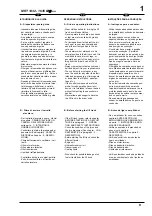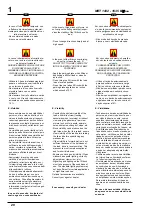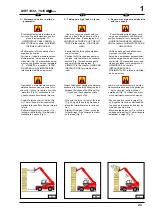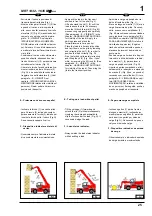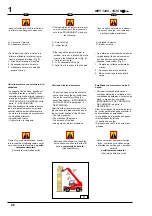
12
1
MRT 1432 - 1635
M
S
Series
IT
- Never move onto a loading platform
without having first checked :
• That it is suitably positioned and made
fast.
• That the unit to which it is connected
(Wagon, lorry, etc.) will not shift.
• That this platform is prescribed for the
total weight of the lift truck to be loa
ded.
• That this platform is prescribed for the
width of the lift truck.
- Never move onto a foot bridge, floor or
freight lift, without being certain that
they are prescribed for the weight and
size of the lift truck to be loaded and
without having checked that they are in
sound working order.
Take extreme care with loading
platforms, trenches, scaffolding, recen-
tly dug and/or backfilled ground.
- The loaded lift truck must not travel
at speeds in excess of 10 km/h.
Movement instructions .
- Check the transmission oil level.
- Raise the forks or attachment to the
transport position approximately 300
mm from the ground.
- Engage the gear required (See
chapter : INSTRUMENTS AND CON-
TROLS in paragraph : 2 - DESCRIP-
TION).
- Select the steering mode chosen.
- Shift the forward/reverse lever to the
selected direction of travel.
- Release the parking brake and accele-
rate gradually until the lift truck moves
off.
E - Stopping the lift truck.
Safety notice.
- Before stopping the lift truck after a
long working period, leave the I.C.
engine idling for a few moments, to
allow the coolant liquid and oil to lower
the temperature of the I.C. engine and
transmission.
- Não ponha o veículo sobre uma pla-
taforma de carga antes de ter verifica-
do:
• Se está correctamente posicionado e
bem fixado.
• Se o meio ao qual a plataforma está
ligada (vagão, camião, etc.) não possa
se mover.
• Se esta plataforma é capaz de susten-
tar o peso total do empilhador e da
sua carga, se presente.
• Se a largura da plataforma de carga é
adequada à largura do empilhador.
- Nunca ponha o veículo sobre uma
passarela, um plano ou um monta-car-
gas, antes de ter a certeza de que
tenham sido previstos para o peso e
para o volume ocupado pelo empilha-
dor e pela sua carga, se presente, e
sem ter verificado se estão em boas
condições.
Preste muita atenção nos cais de
carga, trincheiras, andaimes e terrenos
recentemente escavados ou submeti-
dos a terraplanagem.
- A velocidade de circulação do
empilhador com a carga nunca deve
ultrapassar 10 km/h, em nenhuma
circunstância.
Instruções para o movimento.
- Verifique o nível de óleo na transmis-
são.
- Ponha os garfos ou o acessório na
posição de transporte, ou seja, a cerca
de 300 mm do chão.
- Engate a velocidade escolhida (ver o
capítulo: INSTRUMENTOS DE CON-
TROLO E DE COMANDO na parte: 2 -
DESCRIÇÃO).
- Ponha a alavanca do inversor do sen-
tido de marcha na posição desejada.
- Desengate o travão de estacionamen-
to e acelere suavemente para permitir
a deslocação do empilhador.
E - Paragem do empilhador.
Normas de segurança.
- Antes de parar o empilhador depois de
um trabalho intenso, deixe o motor tér-
mico funcionar ao ralenti durante
alguns instantes, para permitir que o
óleo e o líquido de arrefecimento redu-
zam a temperatura do motor e da tran-
smissão.
- Non immettersi su un ponte di carico
senza aver verificato :
• Che sia correttamente posizionato ed
ancorato.
• Che il mezzo al quale è collegato
(Vagone, camion, ecc.) Non si possa
spostare.
• Che tale ponte possa sopportare il
peso totale del carrello elevatore e del
suo eventuale carico.
• Che la larghezza del ponte sia
adeguata a quella del carrello
elevatore.
- Non immettersi mai su una passerella,
su un pianale o un montacarichi, senza
avere la certezza che essi siano previ-
sti per il peso e l'ingombro del carrello
elevatore e del suo eventuale carico, e
senza aver verificato che essi siano in
buono stato.
Prestare particolare attenzione alle ban-
chine di carico, alle trincee, ai ponteggi,
ai terreni recentemente scavati e/o
riempiti.
- La velocità di circolazione del
carrello elevatore con carico non
deve in nessun caso superare i
10 km/h.
Istruzioni per il movimento.
- Verificare il livello dell'olio della
trasmissione.
- Mettere le forche o l'accessorio nella
posizione di trasporto, ossia a circa
300 mm dal suolo.
- Inserire la marcia scelta (Vedi capitolo :
STRUMENTI DI CONTROLLO E DI
COMANDO nella parte : 2 - DESCRI-
ZIONE).
- Mettere la leva dell'invertitore di marcia
nella posizione desiderata.
- Togliere il freno di stazionamento ed
accelerare dolcemente per consentire
lo spostamento del carrello elevatore.
E - Arresto del carrello elevatore.
Norme di sicurezza.
- Prima di arrestare il carrello elevatore
dopo un intenso lavoro, lasciare il
motore termico girare al minimo per
qualche istante, per permettere al liqui-
do di raffreddamento e all'olio di
abbassare la temperatura del motore e
della trasmissione.
EN
PO
Summary of Contents for M Series
Page 2: ......
Page 10: ......
Page 45: ......
Page 55: ...10 2 MRT 1432 1635 MS Series IT EN PO MRT 1432 pos A 1800 13 6 m Kg Kg Forks500 mm 690791 ...
Page 57: ...12 2 MRT 1432 1635 MS Series IT EN PO MRT 1635 pos A 1800 14 m Kg Kg Forks500 mm 690907 ...
Page 98: ......
Page 116: ...18 3 MRT 1432 1635 MSeries IT EN PO 6 6 6 6 4 4 5 6 6 B13 2 B13 1 4 4 6 5 6 5 4 4 6 5 6 5 ...
Page 138: ...4 4 I IM MP PI IA AN NT TI I S SY YS ST TE EM MS S S SI IS ST TE EM MA AS S ...
Page 139: ......
Page 212: ......
Page 220: ......
Page 236: ......
Page 242: ......
Page 248: ......
Page 254: ......
Page 260: ......
Page 266: ......
Page 272: ......
Page 278: ......
Page 284: ......












